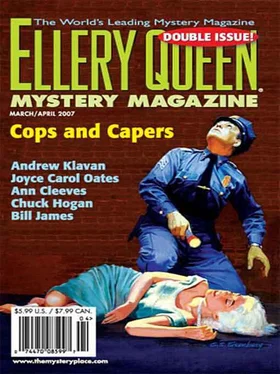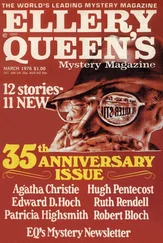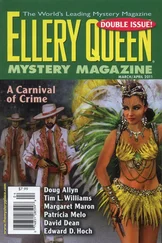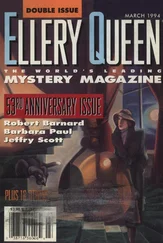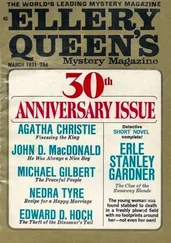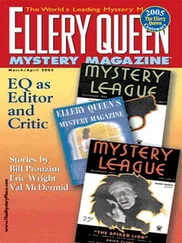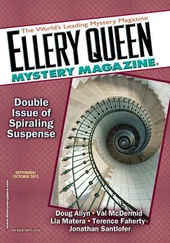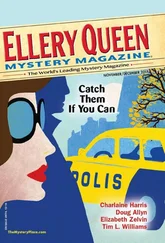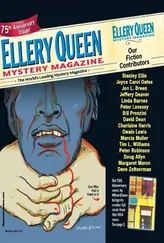Barbara Callahan - Ellery Queen’s Mystery Magazine. Vol. 129, Nos. 3 & 4. Whole Nos. 787 & 788, March/April 2007
Здесь есть возможность читать онлайн «Barbara Callahan - Ellery Queen’s Mystery Magazine. Vol. 129, Nos. 3 & 4. Whole Nos. 787 & 788, March/April 2007» весь текст электронной книги совершенно бесплатно (целиком полную версию без сокращений). В некоторых случаях можно слушать аудио, скачать через торрент в формате fb2 и присутствует краткое содержание. Город: New York, Год выпуска: 2007, ISBN: 2007, Издательство: Dell Magazines, Жанр: Детектив, на английском языке. Описание произведения, (предисловие) а так же отзывы посетителей доступны на портале библиотеки ЛибКат.
- Название:Ellery Queen’s Mystery Magazine. Vol. 129, Nos. 3 & 4. Whole Nos. 787 & 788, March/April 2007
- Автор:
- Издательство:Dell Magazines
- Жанр:
- Год:2007
- Город:New York
- ISBN:ISSN 0013-6328
- Рейтинг книги:3 / 5. Голосов: 1
-
Избранное:Добавить в избранное
- Отзывы:
-
Ваша оценка:
- 60
- 1
- 2
- 3
- 4
- 5
Ellery Queen’s Mystery Magazine. Vol. 129, Nos. 3 & 4. Whole Nos. 787 & 788, March/April 2007: краткое содержание, описание и аннотация
Предлагаем к чтению аннотацию, описание, краткое содержание или предисловие (зависит от того, что написал сам автор книги «Ellery Queen’s Mystery Magazine. Vol. 129, Nos. 3 & 4. Whole Nos. 787 & 788, March/April 2007»). Если вы не нашли необходимую информацию о книге — напишите в комментариях, мы постараемся отыскать её.
Ellery Queen’s Mystery Magazine. Vol. 129, Nos. 3 & 4. Whole Nos. 787 & 788, March/April 2007 — читать онлайн бесплатно полную книгу (весь текст) целиком
Ниже представлен текст книги, разбитый по страницам. Система сохранения места последней прочитанной страницы, позволяет с удобством читать онлайн бесплатно книгу «Ellery Queen’s Mystery Magazine. Vol. 129, Nos. 3 & 4. Whole Nos. 787 & 788, March/April 2007», без необходимости каждый раз заново искать на чём Вы остановились. Поставьте закладку, и сможете в любой момент перейти на страницу, на которой закончили чтение.
Интервал:
Закладка:
Soon Ganelon and his friend were visiting the theater and musical entertainments together. (Since the arrival of their son ten years before, Madame Ganelon seldom ventured abroad.) The two friends made an interesting couple, for Ganelon was short, stout, and taciturn while LeGrand was thin, above average height, and given to rhetorical turns.
That September, they attended a concert given by Glendening Gunderson, the British North American Alpine tusk-horn prodigy. His unusual musical instrument was an elephant tusk drilled from end to end and fitted with a reed mouthpiece and finger holes. The thick curve of the tusk, the bell end, rested on the concert stage while the artist stood on a folding chair with his back to the audience and blew into the other. In Gunderson’s hands the Alpine tusk-horn sounded like a vast piano. That night he brought the astonished audience to its feet with his performance of J. S. Bach’s “Goldberg Variations.”
Later Ganelon and LeGrand sat in their seats waiting for the aisle to clear, a process that took much longer since the introduction of the hoop skirt. (Someone had recently commented that whatever disguise the Devil took in the Garden of Eden, to tempt today’s fashionable women he’d better come as a hoop snake.) While they waited, Ganelon remarked that he’d heard Alpine tusk-horns before, but Gunderson’s instrument possessed an extraordinary vibrato, as if each note was echoing back and forth between the walls of a small Alpine valley.
LeGrand caught his meaning. “What a glorious day for classical music,” he remarked, “if the legendary elephant graveyard in the Alps really did exist and we were the ones to find it!”
The story goes that when Hannibal the Carthaginian general crossed the Alps with his elephants in 218 B.C., his favorite animal, whom he had named the Big Barcelona after his father Hamilcar Barca, took a misstep on the mountain pass and fell to his death in a remote valley. Sad, but with a war to fight against the Romans Hannibal hurried on. But as the other elephants passed by they looked up at the stars as if marking the place.
Now the Big Barcelona, a patriarch among elephants, had many offspring, including an old Tarmac who had pulled the very Roman harrow used to salt defeated Carthage’s ground so nothing would ever grow there again. One day Tarmac smelled a ghost of edelweiss on the wind and knew he would soon die. There and then, he set out for the Alpine valley that held Big Barcelona’s grave. Tarmac dog-paddled the Hellespont, crossed Turkey, Greece, northern Italy, and down to the French Riviera. When he reached the valley of the Rhone River he turned northward and entered the Alps by the Little St. Bernard Pass. Following Hannibal’s route, Tarmac found the Big Barcelona’s valley, lay himself down beside his grandsire’s bones, and died.
For the next few centuries elephant sightings along the Rhone were common. People called them Hannibal’s strays and after the fall of the Roman Empire they viewed the animals kindly, as relics of a happier time. Later the elephants added their ponderous gray to the Dark Ages. Then the simple folk called them dragon caterpillars, believing they headed up into the mountains to weave cocoons and burst forth as flying dragons to rule the Alpine sky. By the Enlightenment, Big Barcelona’s bloodline had thinned and the elephants came no more.
After the concert, a small reception was held for Gunderson at the Polyhymnia. The musician brought his instrument, which he’d found in an old shop dealing in musical curiosities while attending the conservatorium in Leipzig on the Mendelssohn Scholarship.
When Ganelon examined the tusk-horn at close hand he found a small silver plate on the bell end that read: “Made by Hans Lemke of Geneva. 1842. A genuine Alpine tusk-horn. Accept no substitutes.” The italics added an intriguing emphasis.
Among the other club members present that evening was Cornelius O’Hagen, a craggy-faced Ulsterman who played cello in the San Sebastiano Symphony. An Alpine mountain-climbing enthusiast, in 1859 O’Hagen had lost a leg above the knee to frostbite trying to ascend the then unconquered Schreckhorn. “They gave me a cork leg,” he once told Ganelon in mock indignation. “Cork, and me a dues-paying Ulsterman. Why not a Belfast leg?” O’Hagen lived at the Polyhymnia in a room crowded with papier-maché models of the mountains he’d tried to climb. O’Hagen once dared to tell the short-tempered detective-oboist that he pitied woodwind players who have never breathed in noble mountain air and had to make do with tired stuff that had already passed through a million lungs.
Hans Lemke? Ganelon returned home to the rue Blondin convinced he had heard the Alpine tusk-horn maker’s name before and in an elephant-graveyard context. On the stairs to the family living quarters he passed the small closet on the landing which his young son and namesake had turned into a scientific laboratory, making the hallway reek of rotten eggs.
Entering his library he took down from the shelf Swiss Eccentrics and Eccentricities, a recent acquisition. Some day Ganelon thought he might write a similar work about San Sebastiano’s many colorful citizens, suspecting that if he left the job to someone else, his own name would lead the list of eccentrics.
When he turned to the chapter entitled “The Man Who Believed in the Elephant Graveyard in the Alps” Ganelon read, “In the second quarter of this century Hans Lemke, a musical-instrument maker of Geneva, allowed himself to be the victim of an absurd swindle. Lemke, who specialized in the making of Alpine horns from ivory, was working late in his shop when he heard a wheel grind to a halt on the cobbles outside his door. Then came a knock. He lay aside his auger, brushed the curls of ivory from his lap, and found a large man in mountaineer’s dress with his face concealed in an ample cloak. The man, who said his name was Otto Bauer, asked if Lemke was interested in buying an elephant tusk. Yes, came the reply, if it was African ivory, for Lemke deemed Indian ivory only good for making combs and letter openers. The man uncovered a large tusk on the wheelbarrow behind him, carried it into the shop, and put it down by the stove as Lemke directed. As they waited for the ivory to come to room temperature so Lemke could test its tone, he asked where the man had found it.
“Bauer said he worked with the mountain-climbing parties, where his job was to carry piggyback English tourists unable or unwilling to make the ascent on foot. Once his party was caught in a sudden and unseasonable snowstorm. When his cargo dismounted to huddle with the others around a fire beneath a hastily erected canvas shelter, Bauer moved off a bit to answer the call of nature and in the evening gloom he set his foot wrong and fell off the narrow path, tumbling several hundred feet down a steep, snow-covered mountainside.
“Miraculously, he survived the fall uninjured and in the dying light slid right into what he thought was a pile of underbrush on the valley floor. But the sound his crash made was like a large man sitting down on the keyboard of a piano. Bauer’s ears told him he had stumbled on every mountaineer’s dream, the fabled Alpine graveyard where the descendants of Hannibal’s favorite elephant returned to die.
“When the other guides missed Bauer, it was dark and there was nothing they could do until daylight. By then the man had decided he wasn’t going to share his find with anyone. At dawn, when they shouted down to see if he was still alive, Bauer made no answer. So his companions left him for dead.
“When the ivory had warmed, Lemke lay an ear to the tusk and rapped it with his knuckle. The sound told him it was the finest of African ivory and he bought the tusk on the spot. Could Bauer bring him more? Bauer could. But he was a secretive man, coming at night and never entering if a customer was in the shop. A few times he brought his son Conrad, a young mountaineer with a twisted back and his left shoulder higher than the other. Bauer even showed Lemke something wrapped in oilskin, claiming it was the map to the elephant graveyard.
Читать дальшеИнтервал:
Закладка:
Похожие книги на «Ellery Queen’s Mystery Magazine. Vol. 129, Nos. 3 & 4. Whole Nos. 787 & 788, March/April 2007»
Представляем Вашему вниманию похожие книги на «Ellery Queen’s Mystery Magazine. Vol. 129, Nos. 3 & 4. Whole Nos. 787 & 788, March/April 2007» списком для выбора. Мы отобрали схожую по названию и смыслу литературу в надежде предоставить читателям больше вариантов отыскать новые, интересные, ещё непрочитанные произведения.
Обсуждение, отзывы о книге «Ellery Queen’s Mystery Magazine. Vol. 129, Nos. 3 & 4. Whole Nos. 787 & 788, March/April 2007» и просто собственные мнения читателей. Оставьте ваши комментарии, напишите, что Вы думаете о произведении, его смысле или главных героях. Укажите что конкретно понравилось, а что нет, и почему Вы так считаете.
